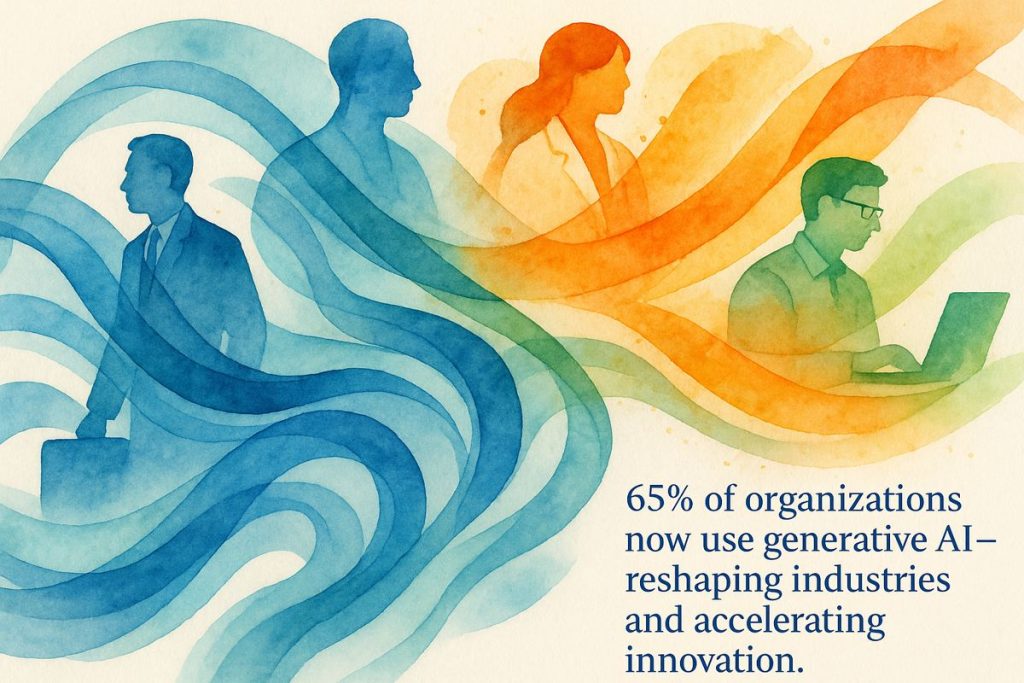In 2025, generative AI is booming in big businesses, especially in fields like finance, law, and science. More companies than ever are using AI for faster customer service, smarter marketing, and quicker research, turning everyday tasks into speedy, automated magic. People still worry about things like privacy and finding enough experts, but the benefits—like big profits and new ways of working—are hard to ignore. Even careful industries are getting curious, as AI changes how work gets done, making the future feel both exciting and a little uncertain.
How is generative AI transforming enterprises in 2025?
Generative AI is transforming enterprises in 2025 by rapidly increasing adoption rates—from 33% to 65%—and delivering significant ROI, especially in sectors like finance, software, legal, and life sciences. It enhances automation, streamlines customer service, accelerates R&D, and boosts marketing personalization, despite ongoing talent and data privacy challenges.
I. A New Epoch Dawns—Or Does It?
Is it just me, or does the rush toward generative AI in the enterprise feel a bit like watching a troupe of caffeinated engineers attempt ballet? Beautiful, awkward, and—let’s face it—occasionally hazardous. Since early 2024, the adoption of generative AI has ballooned from a humble 33% to an eye-watering 65% of organizations, at least if AmplifAI and Akooda have their numbers straight. North America, predictably, leads the pack: 40% of companies there are already experimenting, although only about one in ten have managed true integration.
And yet, who are the trailblazers? Not your corner bakery, that’s for sure. The vanguard is made up of professional services, finance behemoths, and software firms—the sort for whom operational efficiency is less a buzzword and more a state religion. Sectors like manufacturing and government, bound by regulatory palimpsests, look on with measured curiosity, perhaps muttering, “Not yet, comrade.” I’ll admit, I once thought the bureaucratic inertia would grind AI to a halt—turns out, even the slowest behemoths can pirouette when the music is right.
Crucially, early adopters aren’t just chasing hype. For every dollar invested, companies are gleaning $3.70 in return—automation, productivity, even a certain je ne sais quoi of operational élan (ITPro). Not too shabby when you consider the average expense report is about as thrilling as a three-day-old blini.
II. Customer Conversations: Synthetic, Yet Surprisingly Savory
The customer service landscape has been dunked—no, saturated—in AI this year. Telekom giants like Deutsche Telekom now wield AI assistants projected to field 38 million customer interactions annually (Rasa). That’s not hyperbole; that’s hyperscale. Suddenly, the once-mundane crackle of a call center line is replaced by sleek, context-aware bots capable of parsing everything from billing queries to the existential malaise of a dropped signal.
Still, the path to customer delight is studded with metaphorical potholes. Three-quarters of customers (yes, three out of four) fret about data privacy, a concern as sticky as undercooked pelmeni. Meanwhile, 45% of enterprises admit they simply lack enough AI-savvy professionals—a talent drought threatening to turn this AI renaissance into a mirage (Coherent Solutions). I remember the first time I tried integrating an LLM-based chatbot for a client—let’s just say the bot’s attempts at small talk were…memorable. “How can I help you today, fellow carbon-based life form?” Oof.
And yet, despite the digital hiccups and synthetic stumbles, the trajectory is clear: automated service is evolving from a blunt instrument into a hyperspectral lens, refracting customer needs into actionable insights at dazzling speed. The sound of chatbots at work? Somewhere between a low hum and the gentle fizz of seltzer—comforting, if not quite human.
III. Legal, Life Sciences, and the Alchemy of Productivity
If you’d told me in 2022 that lawyers would be among the first to fall for generative AI, I’d have raised an eyebrow. But behold: usage among legal professionals has jumped from 14% last year to 26% now, and almost all (well, 95%) expect AI to become central to their practice in five years (AmplifAI). The daily grind of reviewing contracts—what used to be the Sisyphean boulder of legal work—is now a task for the algorithmic underlings.
And what about pharma? Here, generative AI feels almost mythic. Where drug discovery once moved at the glacial pace of a Dostoevsky subplot, platforms like DataRobot and Salesforce have compressed R&D timelines from years to months (Akooda). I recently heard a story from a colleague at Snowflake: they watched, wide-eyed, as an AI-driven model predicted molecular interactions in under 24 hours. The air, he said, practically crackled with anticipation—and maybe a hint of burnt coffee.
Of course, these miracles come with their own side effects: compliance headaches, data security, and the gnawing fear that your job description might morph overnight into something unrecognizable. There was a time when I worried that all this AI would put me out of a job; now I see it’s just rewriting the palimpsest, not erasing it.
IV. Marketing, Metrics, and the Human Quirk
In the marketing world, generative AI is the new chef—whipping up personalized content at breakneck speed. Michaels, the arts-and-crafts retailer, ramped up its personalized emails from 20% to 95% and saw click-through rates jump 25%. SMS campaigns? Up 41% (McKinsey). That’s not just needle-moving; that’s needle-vaporizing.
Yet AI’s efficiency is both a blessing and, occasionally, a curse. Marketers now wrestle with the challenge of keeping messaging authentic, lest their campaigns sound like they were
